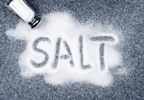 More than 40 million people in the United States have osteoporosis or are at risk of developing osteoporosis because of low bone mass. With the staggering number of people suffering from this condition, researchers are always studying to learn more about the causes and treatments for this disease. Scientists have often wondered why individuals who eat a diet high in salt have higher rates of kidney stones and osteoporosis and researchers from the University of Alberta may have discovered why…
More than 40 million people in the United States have osteoporosis or are at risk of developing osteoporosis because of low bone mass. With the staggering number of people suffering from this condition, researchers are always studying to learn more about the causes and treatments for this disease. Scientists have often wondered why individuals who eat a diet high in salt have higher rates of kidney stones and osteoporosis and researchers from the University of Alberta may have discovered why…
The Link between Salt and Osteoporosis – The Body.
Advertisement
When sodium levels in the body are too high, the body excretes it in the urine and takes calcium along for the ride thereby decreasing calcium levels in the body. When calcium levels are high in the urine, kidney stones can develop and when calcium levels are low in the body, osteoporosis can develop. The findings from this study suggest that as we continue to consume more and more salt in our diets, we will also continue to deplete the calcium stores in our body which can result in the development of osteoporosis. The results from this study reinforce the need for us to change our eating habits and consume low sodium diets.
The findings from this study also provide insight into the possibility of developing a drug using the molecule that is responsible for regulating sodium and calcium in the body. This could lead to the development of a new treatment option for osteoporosis.
The “Silent Disease” – Aches and Pains
Osteoporosis occurs when the bones in the body become weak, making them more susceptible to fracture. Osteoporosis is commonly referred to as the “silent disease” because bone loss can occur with no symptoms at all. However, if osteoporosis is severe, it can cause fractures and/or a condition known as kyphosis (you may recognize this as a hump in the upper back – “Dowager’s hump”). Common places for fractures for individuals with osteoporosis include the wrists, hips and spine. Fractures and kyphosis can both cause severe pain. The pain that is experienced with complications of osteoporosis can be much more severe than the aches and pain many people experience with aging. The pain associated with osteoporosis often makes many people seek out pain relief options.
Pain Relief Options
Medication is the most common way to relieve pain that is associated with osteoporosis. However, there are many alternative pain relief options available including:
Ice & Heat – heat can help to relieve pain caused by tense muscles while ice can help to reduce swelling and inflammation.
Massage & Acupuncture – both of these treatments can help to relieve pain and tension caused by osteoporosis.
Exercise – an important step for pain relief is to keep active. If you are unable to do this on your own, seek the expertise of a physiotherapist to help maintain your bone health and muscle strength.
Additionally, there are a variety of psychological approaches to pain relief including:
Advertisement
Relaxation techniques – concentrating on your breathing will help to relax tense muscles and relieve pain.
Psychotherapy – the chronic pain that may be associated with osteoporosis can lead to stress and depression. Speaking with a professional will help you to learn how to cope with these feelings.
Salt is never something that should be added to your diet in heavy doses, but if osteoporosis wasn’t something that was on the radar when you reached for the salt shaker, perhaps it will be now.
